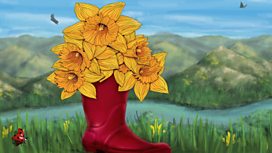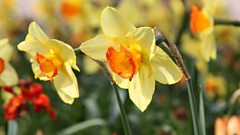Daffodils
Brett Westwood explores the role daffodils play in art, medicine, literature and belief. They are harbingers of spring and signs of hope, also of self obsession in Greek mythology.
Wordsworth's famous poem is always in the top 5 most loved poems in English. His encounter with daffodils in the Lake District has become a romantic expression of our relationship with nature. They are radiant beauties that bring hope to the heart after the long winter months. The native flowers are delicate and small, unlike the cultivated, rather brash varieties that adorn roadside verges and roundabouts, creating much daffodil snobbery. Daffodils are the national flower of Wales, though only since the 19th Century, promoted by Lloyd George who thought them more attractive than leeks. Attractiveness though led them to be associated with vanity, the Greek Narcissus (daffodils in Latin: narcissus) fell in love with his own reflection and pined away. Their appearance in Lent gives them the name Lenten Lilly and associated with resurrection, but in Eastern cultures it is the flower of wealth and good fortune. It has been used throughout history as a medicine, despite being toxic. Today it is grown extensively in Wales as its bulb contains galantamine, a drug used in the treatment of Alzheimer's. Whatever way you look at daffodils they are quintessentially a part of human cultures wherever it grows and can be considered the flower that brightens Britain after long, cold winters.
Producer : Sarah Pitt
Archive Producer : Andrew Dawes
Revised Repeat : First Broadcast ���˿��� Radio 4; 28th August 2015
Last on
![]()
How to decode floriography, the language of flowers.
![]()
The World According to Daffodil
Natural Histories Comedy - Take your places for the Wordsworth daffodil tribute act.
Clips
-
![]()
The World According to Daffodil
Duration: 01:45
-
![]()
William Wordsworth's Daffodils
Duration: 02:25
Dr Fred Rumsey

He also provides expert taxonomic advice to various Taxon Groups, sits on the specialist groups and referees for several families for the .
Professor Sally Bushell

Her first book was . She then co-edited the Cornell edition of The Excursion and published Text as Process: Creative Composition in Wordsworth, Tennyson and Dickinson.
Monty Don

He lives close to the land, not only through his garden which features weekly on Gardeners’ World but in the hills near where he lives, where he farms sheep.
Fflur Gwynn

She has an MA in History of Design from the V&A Museum and the Royal College of Art and her specialist subjects include Welsh music and popular culture and 20th century craft.
Professor Jane Lawrence

Jayne is particularly interested in understanding how the structure of a molecule influences the molecular architecture of the delivery vehicle it forms and its fate in the target cell. To achieve these aims she uses a range of advanced analytical techniques including light and neutron scattering and reflectivity.
Dr Fleur Rothschild

Fleur has lectured on Chaucer, Shakespeare and Early Modern drama and is currently the Learning Development Co-ordinator and Tutor for the School of Arts. She has an abiding passion for plants of all kinds and is a guerrilla gardener. A particular fascination is with daffodils and she has a book forthcoming on Reaktion Press about the daffodil's horticultural and cultural history.
Broadcasts
- Tue 25 Aug 2015 11:00���˿��� Radio 4
- Mon 31 Aug 2015 21:00���˿��� Radio 4
- Sun 7 Mar 2021 06:35���˿��� Radio 4






